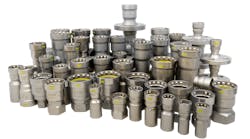San Francisco — Building Information Modeling is credited for many things, but spreading goodwill usually isn't one of them. Yet that's what happened when Marelich Mechanical built out a laboratory floor at the campus of the University of California at San Francisco. When they neared the end of the job, the lead scientist at the lab ran into the project managers and wanted to go to lunch to catch up on things.
UCSF has about 50 floors of laboratory space throughout its campus and some of them are undergoing renovation all the time, even if it's just a third of a floor.
Marelich worked previously at UC San Francisco so its reputation preceded it. Its ability to perform both plumbing and mechanical scopes gave general contractor JW & Sons, Petaluma, Calif., the peace off mind to combine the segments and award the job to Marelich, even though the EMCOR Group unit was not the low bidder.
It was thus that Senior Project Manager Daniel Clifford and Project Executive Andy Beering and their team found themselves retrofitting a laboratory floor with 10 different plumbing systems, five fume hoods with stainless steel exhausts, and adding onto and tying into an existing mechanical system.
The university always brings the lead scientist for a lab into the planning process so the facility is built pretty much to his or her exact requirements.
The plumbing systems include domestic cold water, domestic hot water, domestic hot water return, polypropylene acid waste, waste piping, nitrogen, vacuum, air, gas, and emergency eyewash. All told, the Marelich crew installed 11,000-ft. of pipe for plumbing systems.
Mechanical systems included 28 VAV zones, six cooling coils, three supplemental air conditioning units for electrical, data and mechanical rooms, and the fume hoods. The mechanical systems used 3,200-linear ft. of ductwork and 2,000-ft. of hydronic piping.
“It's the fourth floor of an existing facility,” Beering explained. “The building had been around for a long time and constantly upgraded. To get to the fourth floor from the street, you have got to get on an elevator. But in the back of building it was just one level up, so we could access the space via a window that was removed to allow us to get material, tools and equipment in there relatively easily, avoiding an elevator situation.”
Because the job took place in an existing building that had been remodeled a number of times, it was one, giant concealed condition. The university wisely awarded the demolition contract first so that the plumbing and mechanical bidders could compete on an even field.
The laboratory mechanical systems were all installed in a congested ceiling space, requiring a thorough coordination effort to get everything in. Beering and Clifford used Autodesk Navisworks for collision detection. Marelich took the lead in terms of coordination since both the dry and wet sides of the HVAC system and the plumbing were 85% of the job. They also worked with the electrician that had a challenging system to cram into the ceiling space too.
“The Navisworks clash detection allowed for a real good first pass,” Beering said. “I'd be lying if I said it was 100% flawless. There were a few bumps in the road, but 95% of conflicts were avoided.”
Added Clifford, “One thing I would emphasize is that this project was the first time the university used a BIM model and they have requested in every RFP since to use BIM.”
The recently completed project took 15 months and Marelich was finished with everything except the custom cabinetry in nine months, Clifford said. The largest crew needed was four sheet metal workers and that was mostly to maneuver ductwork through the window. A savvy GC that understood scheduling and coordination helped keep crew sizes down.
“Sometimes the general contractor will want to put up walls so they can press the owner for progress payments,” Beering said. “This GC, through the scheduling meetings on the site, recognized the need to get mechanical systems overhead and coordinate the architectural features around the mechanical features. We found areas where they could work without impacting the overhead rough in and allowed the overhead to run its course. Then they came in and built out the architectural features, which allowed the schedule to shorten.”
The BIM, Clifford explained, allowed the GC to install studs for full-height firewalls and miss all of the ductwork and piping. Three months later when the mechanical was in, JW & Sons came back and installed the drywall.
Marelich sent a detailer out to the site for about three days and used her input for the BIM model. BIM allowed 65%-70% of the plumbing and as much as 80% of the pipefitting to be prefabricated in the contractor's shop.
Laboratories on floors above and below complicated the job; waste lines, for example, ran through the space and Marelich had to tie into existing HVAC and exhaust systems.
“For the lab gases, the lateral runs were prefabricated,” Clifford explained. “The only thing that was not prefabricated was the verticals from the ceiling. They call them ‘umbilicals,’ it's a shaft with conduit and lab gases running down it. We did not prefab those because we could not get enough drawings from the bench manufacturers to do it.
“The biggest issue we had to overcome was on the air side,” Clifford continued. “There was existing ductwork we had to connect to and a limited amount of space. The cooling coils were very heavy and very large and we had to get them up in first and attach the seismic braces and hangers. There was a trapezoidal ceiling system where we had 36-in. × 48-in. duct that had to drop down to a tiny aspect ratio shaped like a trapezoid that then blows up to the original size at the other side. We did that at least four times with each duct line.”
The contractor also had to tie into the existing exhaust system.
All of the plumbing is stainless steel. The piping is set up into what is referred to as “turrets,” series of large valves on a backing plate containing piping for compressed air, vacuum, nitrogen and gas. That piping runs from under the cabinets up to barbed fittings to which the end user can hook up tubing.
Marelich also installed sinks with four emergency eyewashes and two emergency showers. The showers had to be located within a few feet of a sink, so that a blinded user could take a couple steps over and wash off.
The contractor installed the three 1-1/2 to 2-ton air conditioning units in the electrical, data and mechanical rooms at the behest of the consulting engineer because in his experience those rooms are susceptible to overheating.
In addition to its newfound appreciation of BIM, the success of the project has moved the university to move away from bid-and-spec to a “best value” system. The best value contracting method is a points awards program based on a contractor's resume, team, experience, input on the schedule, and its overall approach to a project. Competing teams will fill out a lengthy bid form from which the university will award points. Three to six judges will evaluate the proposals and the judges can question the contenders about their qualifications.

